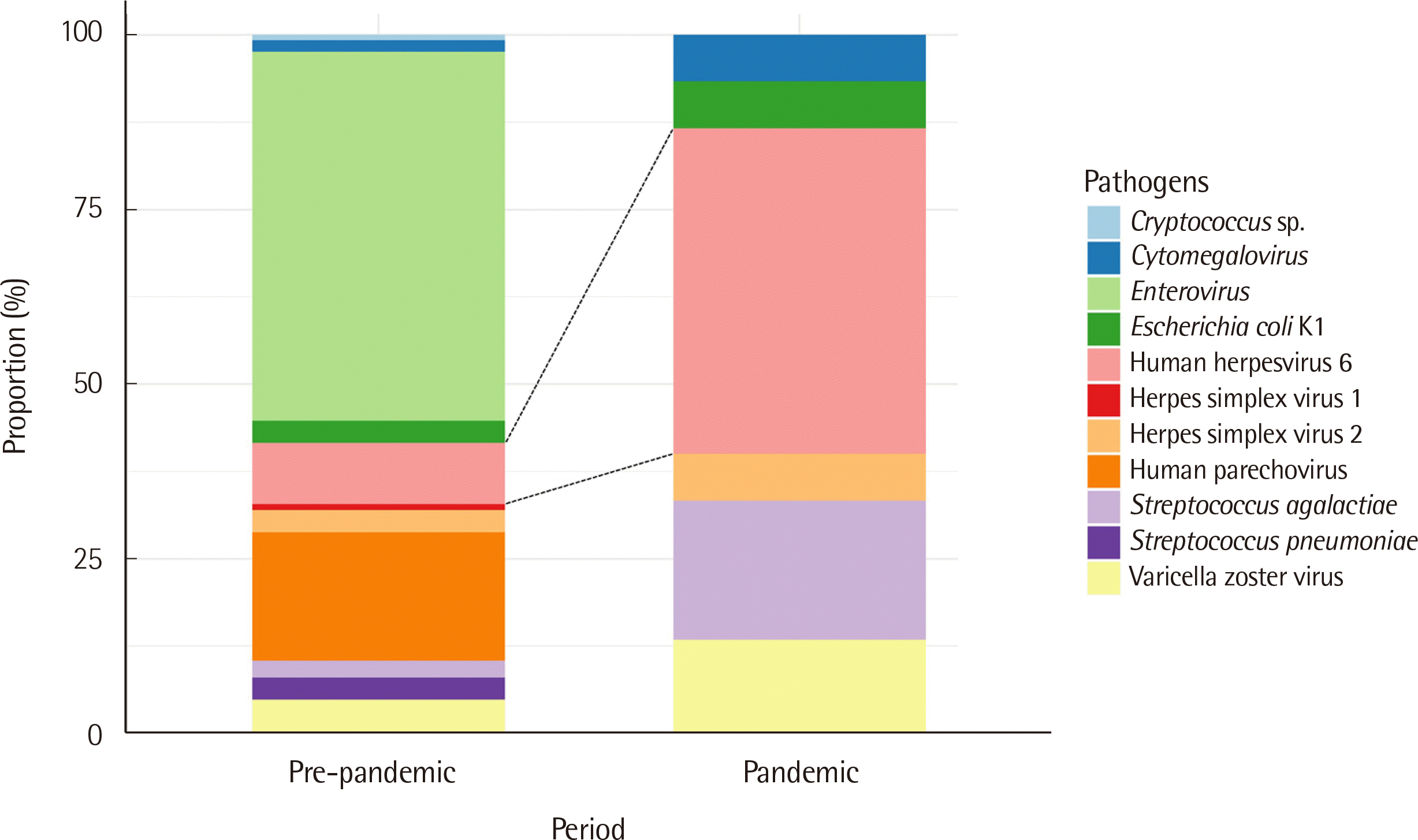1. Hartley DM, Perencevich EN. 2020; Public health interventions for COVID-19: emerging evidence and implications for an evolving public health crisis. JAMA. 323:1908–9. DOI:
10.1001/jama.2020.5910. PMID:
32275299.
4. Huh K, Jung J, Hong J, Kim M, Ahn JG, Kim JH, et al. 2021; Impact of nonpharmaceutical interventions on the incidence of respiratory infections during the Coronavirus disease 2019 (COVID-19) outbreak in Korea: a Nationwide Surveillance Study. Clin Infect Dis. 72:e184–91. DOI:
10.1093/cid/ciaa1682. PMID:
33150393. PMCID:
PMC7665442.
5. Ullrich A, Schranz M, Rexroth U, Hamouda O, Schaade L, Diercke M, et al. 2021; Impact of the COVID-19 pandemic and associated non-pharmaceutical interventions on other notifiable infectious diseases in Germany: an analysis of national surveillance data during week 1-2016 - week 32-2020. Lancet Reg Health Eur. 6:100103. DOI:
10.1016/j.lanepe.2021.100103. PMID:
34557831. PMCID:
PMC8454829.
6. Amar S, Avni YS, O'Rourke N, Michael T. 2022; Prevalence of common infectious diseases after COVID-19 vaccination and easing of pandemic restrictions in Israel. JAMA Netw Open. 5:e2146175. DOI:
10.1001/jamanetworkopen.2021.46175. PMID:
35103792. PMCID:
PMC8808334.
7. Tansarli GS, Chapin KC. 2020; Diagnostic test accuracy of the BioFire
® FilmArray
® meningitis/encephalitis panel: a systematic review and meta-analysis. Clin Microbiol Infect. 26:281–90. DOI:
10.1016/j.cmi.2019.11.016. PMID:
31760115.
9. Pellett PE, Ablashi DV, Ambros PF, Agut H, Caserta MT, Descamps V, et al. 2012; Chromosomally integrated human herpesvirus 6: questions and answers. Rev Med Virol. 22:144–55. DOI:
10.1002/rmv.715. PMID:
22052666. PMCID:
PMC3498727.
10. Green DA, Pereira M, Miko B, Radmard S, Whittier S, Thakur K. 2018; Clinical significance of human herpesvirus 6 positivity on the FilmArray Meningitis/Encephalitis panel. Clin Infect Dis. 67:1125–8. DOI:
10.1093/cid/ciy288. PMID:
29635334. PMCID:
PMC7108106.
11. Milburn J, Lechiile K, Siamisang K, Williams CG, Owen L, Gwakuba E, et al. 2022; Human herpesvirus-6 detection in cerebrospinal fluid on the BioFire FilmArray Meningitis/Encephalitis panel in a high human immunodeficiency virus-prevalence African setting. Open Forum Infect Dis. 9:ofac229. DOI:
10.1093/ofid/ofac229. PMID:
35854999. PMCID:
PMC9280324.
12. Pandey U, Greninger AL, Levin GR, Jerome KR, Anand VC, Dien Bard J. 2020; Pathogen or bystander: clinical significance of detecting human herpesvirus 6 in pediatric cerebrospinal fluid. J Clin Microbiol. 58:e00313–20. DOI:
10.1128/JCM.00313-20. PMID:
32102858. PMCID:
PMC7180253.
13. Slenker AK, Royer TL, Villalobos T. 2019; Human herpesvirus 6 positivity on the FilmArray Meningitis/Encephalitis panel needs clinical interpretation. Clin Infect Dis. 69:192–4. DOI:
10.1093/cid/ciz058. PMID:
30689806.
14. Pruksananonda P, Hall CB, Insel RA, McIntyre K, Pellett PE, Long CE, et al. 1992; Primary human herpesvirus 6 infection in young children. N Engl J Med. 326:1445–50. DOI:
10.1056/NEJM199205283262201. PMID:
1315416.
15. Yao K, Crawford JR, Komaroff AL, Ablashi DV, Jacobson S. 2010; Review part 2: human herpesvirus-6 in central nervous system diseases. J Med Virol. 82:1669–78. DOI:
10.1002/jmv.21861. PMID:
20827763. PMCID:
PMC4758195.
16. Maldonado-Barrueco A, García-Rodríguez J, Yániz-Ramirez J, Serrano-Vaquero I, Parra-Alonso JC, Vega-Nieto C, et al. 2022; Impact of the SARS-CoV-2 pandemic on the prevalence and incidence of gastrointestinal viruses in children up to five years old: a retrospective cohort study. Microbiol Spectr. 10:e0266921. DOI:
10.1128/spectrum.02669-21. PMID:
35638853. PMCID:
PMC9241842.
17. Bruggink LD, Garcia-Clapes A, Tran T, Druce JD, Thorley BR. 2021; Decre-ased incidence of enterovirus and norovirus infections during the COVID-19 pandemic, Victoria, Australia, 2020. Commun Dis Intell (2018). 45. DOI:
10.33321/cdi.2021.45.5.
18. Kraay ANM, Han P, Kambhampati AK, Wikswo ME, Mirza SA, Lopman BA. 2021; Impact of nonpharmaceutical interventions for severe acute respiratory syndrome coronavirus 2 on norovirus outbreaks: an analysis of outbreaks reported by 9 US states. J Infect Dis. 224:9–13. DOI:
10.1093/infdis/jiab093. PMID:
33606027. PMCID:
PMC7928764.
19. Chen CHS, Cheng TJ. 2020; Reduction of influenza and enterovirus infection in Taiwan during the COVID-19 pandemic. Aerosol Air Qual Res. 20:2071–4. DOI:
10.4209/aaqr.2020.05.0248.
21. Olijve L, Jennings L, Walls T. 2017; Human parechovirus: an increasingly recognized cause of sepsis-like illness in young infants. Clin Microbiol Rev. 31:e00047–17. DOI:
10.1128/CMR.00047-17. PMID:
29142080. PMCID:
PMC5740974.
23. Levy JA, Ferro F, Greenspan D, Lennette ET. 1990; Frequent isolation of HHV-6 from saliva and high seroprevalence of the virus in the population. Lancet. 335:1047–50. DOI:
10.1016/0140-6736(90)92628-U. PMID:
1970369.
24. Okuno T, Takahashi K, Balachandra K, Shiraki K, Yamanishi K, Takahashi M, et al. 1989; Seroepidemiology of human herpesvirus 6 infection in normal children and adults. J Clin Microbiol. 27:651–3. DOI:
10.1128/jcm.27.4.651-653.1989. PMID:
2542358. PMCID:
PMC267390.
25. Cone RW, Huang ML, Ashley R, Corey L. 1993; Human herpesvirus 6 DNA in peripheral blood cells and saliva from immunocompetent individuals. J Clin Microbiol. 31:1262–7. DOI:
10.1128/jcm.31.5.1262-1267.1993. PMID:
8388889. PMCID:
PMC262915.
26. Ogata M, Satou T, Kadota J, Saito N, Yoshida T, Okumura H, et al. 2013; Human herpesvirus 6 (HHV-6) reactivation and HHV-6 encephalitis after allogeneic hematopoietic cell transplantation: a multicenter, prospective study. Clin Infect Dis. 57:671–81. DOI:
10.1093/cid/cit358. PMID:
23723198.
27. Zerr DM. 2006; Human herpesvirus 6 and central nervous system disease in hematopoietic cell transplantation. J Clin Virol. 37(S1):S52–6. DOI:
10.1016/S1386-6532(06)70012-9. PMID:
17276370.
28. Clark DA. 2016; Clinical and laboratory features of human herpesvirus 6 chromosomal integration. Clin Microbiol Infect. 22:333–9. DOI:
10.1016/j.cmi.2015.12.022. PMID:
26802216.
29. Berzero G, Campanini G, Vegezzi E, Paoletti M, Pichiecchio A, Simoncelli AM, et al. 2021; Human herpesvirus 6 encephalitis in immunocompetent and immunocompromised hosts. Neurol Neuroimmunol Neuroinflamm. 8:e942. DOI:
10.1212/NXI.0000000000000942. PMID:
33587722. PMCID:
PMC7963435.
30. Ablashi D, Agut H, Alvarez-Lafuente R, Clark DA, Dewhurst S, DiLuca D, et al. 2014; Classification of HHV-6A and HHV-6B as distinct viruses. Arch Virol. 159:863–70. DOI:
10.1007/s00705-013-1902-5. PMID:
24193951. PMCID:
PMC4750402.




 PDF
PDF Citation
Citation Print
Print




 XML Download
XML Download